El inglés va hoy primero, desplazaros hacia abajo para el español.
In the previous entry I exposed seven key points where the doctrines of the Roman Catholic Church (RCC for short) directly contradict the teachings of the Holy Scriptures. How can this be, when the RCC prides herself in being the very Church founded by Jesus Christ almost 2,000 years ago, and her head, the Pope, the Bishop of Rome, declares himself to be the representative of Jesus Christ on earth, akin to being God on earth?
The RCC claims to have its start in Matthew 16:18 when Christ supposedly appointed Simon Peter as the first Pope after the following conversation:
15 He saith unto them, But whom say ye that I am?
16 And Simon Peter answered and said, Thou art the Christ, the Son of the living God.
17 And Jesus answered and said unto him, Blessed art thou, Simon Barjona: for flesh and blood hath not revealed it unto thee, but my Father which is in heaven.
18 And I say also unto thee, That thou art Peter, and upon this rock I will build my church; and the gates of hell shall not prevail against it.
19 And I will give unto thee the keys of the kingdom of heaven: and whatsoever thou shalt bind on earth shall be bound in heaven: and whatsoever thou shalt loose on earth shall be loosed in heaven.
Any honest student of the scriptures finds out a few facts about the meaning of verse 18 and about the apostle Simon Peter:
- The rock upon which Jesus Christ was going to build His Church was Himself, not Peter. Jesus did change Simon’s name to Peter (Cephas in Aramaic) when they first met (John 1:42), not later on when Peter made this confession of faith that Jesus was the Christ in Matthew 16:16-18. “Cephas” is the Aramaic equivalent to “Petros” in Greek, from which we get “Peter” in English. The term that Jesus used to refer to Peter in the NT Greek is Petros, “Πέτρος”, which means “ a stone”, or “a boulder”, something that can be moved with the currents or with difficulties. The term He used in that same verse to refer to the foundational Rock of the Church (and upon this rock I will build my church) is the Greek Petra, “πέτρα”, which means “a large mass of rock”, something that cannot be moved. Thus, Jesus was making in that verse a clear distinction between Himself, the unmovable Rock, the foundation of His Church, and Peter, a human that became one of the leaders of the early Church in Jerusalem, but a human nonetheless who could be moved and swayed.+
- Peter was one of the leaders in the early Church and was never recognized as the one above all others. At the Council of Jerusalem Peter took part in the talks, but it was the Apostle James, not Peter, who presided and pronounced the decision of the Council: “When they finished speaking, James answered, saying: Hear me, brethren … Therefore, I judge …” (Acts 15:13, 19).
The other apostles did not recognize Peter as their leader; in fact, they sent him to preach in Samaria (not the other way around): “Now when the apostles which were at Jerusalem heard that Samaria had received the word of God, they sent unto them Peter and John:” (Acts 8:14).
- The apostle Paul never believed that Peter was the Church leader, in fact, Paul, who wasn’t one of the original 12 apostles, reprimanded Peter severely in Galatians chapter 2, when Paul saw that Peter was behaving in an hypocritical manner.
- If Peter was the leader, it would have been the duty of Paul and the other apostles to recognize him as such, to respect him as chief and to teach in their writings that he was the chief; but neither the Gospels, the Acts of the Apostles, the Epistles, nor Revelation ever mention this.
Another startling discovery that the honest and objective student of the Scriptures and History soon makes is that the foundation of the Roman Catholic church is none other than the pagan mystery religion of ancient Babylon. This ancient religion is the origin of many of the Mystery Schools, which was also the foundation of the religion of ancient Egypt, and which forms the basis for the belief systems of modern day secret societies such as Freemasonry and Rosicrucianism. The basis of this belief system is sun worship, personalized in the first “holy trinity” ever worshiped on this earth, the first royal family of ancient Babylon: Nimrod, his wife Semiramis, and Semiramis’ son Tammuz, as was exposed by Alexander Hislop in his remarkable 1853 book The Two Babylons.
King Nimrod appears in the Bible in the 10th chapter of Genesis, as the first King of Babel, later known as Babylon, the first empire that reigned on the earth after Noah’s flood. Only eight souls were left on this earth after the flood: Noah, his wife, their three sons, Shem, Ham, and Japheth, and their three wives. Every human on earth right now is descendant from one of the three sons of Noah, as science proves, subject which I will write about in the future, because it is the nails in the coffin for any Bible denier.
After the deluge, the enemy of God and humankind, Satan, of whom I spoke in “The problem of evil, Part II”, saw himself defeated by God, because the only family left, Noah’s family, were worshipers of the true God Yahweh, and followed His precepts and laws. But soon Satan gained a foothold on humankind again by perverting one of Noah’s sons, Ham, and specially Ham’s son, Cush.
Satan’s foothold on humanity had its continuation after the flood at Babylon with the construction of the Tower of Babel on the plain of Shinar by the River Euphrates, a few generations after the deluge. At the time of the construction of Babylon (Genesis 11:1-4), mankind had multiplied and spoke one language. Nimrod, was the son of Cush, who was the son of Ham, the son of Noah; so, Nimrod was the great-grandson of Noah. Cush helped plan with his son Nimrod a blueprint by which to rule humanity through a wicked counterfeit religion. Nimrod was the originator of sun worship and founder of Babylon. A Bible translation called the Targum says, “Nimrod became a mighty man of sin, a murderer of innocent men, and a rebel before the Lord.”
Nimrod’s evil plan had its origin at Babel which was later known as Babylon. This city of Babylon with a tower “whose top may reach unto heaven” was built by Nimrod (Genesis 10:8-10; 11:4). They called the tower “Babel, the gate to heaven,” but God called it what it really was, “Babel, confusion,” for there, God confused the language of the people, which forced them to scatter. This heaven defying group of people wanted one government to rule the world and one religion to sway the hearts of mankind. This was Satan’s attempt to defy God and His authority, and the ring leader of his scheme was Nimrod. But God came down and stopped this worldwide rebellion at Babel, in defiance of His command for mankind to replenish the earth (Genesis 9:1), by confusing their language into many languages so they could not understand one another’s speech. Mankind discontinued the building of Babel and were scattered to different parts of the world (Genesis 11:8-9).
However, Nimrod was not deterred from knitting together and strengthening this evil religious system and so he married his own mother, Semiramis. She was the first deified queen of Babylon and Nimrod was the first deified king. Semiramis was as wicked as her son Nimrod, and as much sold out to Satan and devil worship as he was. Incest was used as a basis to unite this newly false religious system. Nimrod and his mother/wife would be greatly used by Satan in the following centuries to create every counterfeit religious system on the planet.
Satan’s plan was to develop a counterfeit, opposition system of religion to attract worship away from the true God of Heaven, Yahweh. This false system had its sacrificial plan just as God had a plan for sacrifices. But Satan’s pagan worship required the offering up of human beings, which was often the sons and daughters of the worshipers. A counterfeit holy day was instituted in honor of the sun god, (Sun-day) and this was designed by Satan to rob God of his peculiar authority as the Creator of the universe as designated by His holy day, the Sabbath.
Nimrod’s and Semiramis’ followers plunged so deeply into sin and the occult that they even sacrificed babies to Satan in their worship of him. This became a common practice until Shem, one of Noah’s three sons, and the great uncle of Nimrod, in his anger and wrath killed Nimrod and cut him up into small pieces as an example to others not to commit such abominable sins and not to follow such evil religious practices. Shem was a godly man and it was through his lineage that Jesus the Messiah would come.
Alexander Hislop said in The Two Babylons, “the Tower of Babel was actually the worship of Satan in the form of fire, the sun and the serpent. However, Satan worship could not be done openly because of the many who still believed in the true God of Noah. So a mystery religion began at Babel where Satan could be worshipped in secret.”
Because of Nimrod’s death, his followers were stunned and experienced much grief. Their hero was dead. They were afraid to continue in their worship of Satan for fear that what happened to Nimrod would also happen to them, so a mystery religion developed at Babel where Satan could be worshipped in secret. This is exactly what is happening in these last days. Satan is using mysteries and deceptions to deceive people into thinking that they are worshipping God when they are actually worshipping him (I will write more about this in a future entry).
For a short time, the practices of this counterfeit religion ceased, but Semiramis, the wife of Nimrod, had a brilliant idea of how she could successfully revive her and Nimrod’s pagan religion and give it a new form. It was not long after the death of her husband that Semiramis became pregnant. She said that when Nimrod died he went up to the sun, and the sun then became a symbol of Nimrod. She told the people that a ray of the sun had come to her and impregnated her with a child and that it was actually Nimrod coming back in a reincarnation of the sun god. The child was called Tammuz and these three, Nimrod, Semiramis and Tammuz were worshipped as the personification of the sun god, and this is where we find the three-in-one trinity doctrine originated. This mystery religion was nothing more than Satan worship. Read the pagan origins of the trinity doctrine for more.
“The trinity got its start in Ancient Babylon with Nimrod – Tammuz – and Semiramis. Semiramis demanded worship for both her husband and her son as well as herself. She claimed that her son, was both the father and the son. Yes, he was “god the father” and “god the son” – The first divine incomprehensible trinity.” – The Two Babylons; Alexander Hislop, p.51
Semiramis proclaimed that her husband Nimrod was a god, and she, as the wife of Nimrod, was a goddess. She then announced herself to be “The Queen of Heaven” and that she should be worshiped as such. She claimed that her spirit was the moon and when she died she would dwell in the moon, even as Nimrod was already in the sun. What a diabolical brainstorm inspired by Satan!
Satan was laying the foundation for every system of falsehood and error the world has ever known. They took the truth of God and turned it into a lie and “worshipped and served the creature (including also Satan) more than the Creator.” (Romans 1:25). This system of paganism, while professing to be the true religion, is actually devil worship. It professes and claims to be the truth of God but in reality, it is Satan’s masterpiece, the “mystery of iniquity.”
As Satan’s church gained momentum, Semiramis pushed this satanic religious order underground. The followers of this counterfeit religion had to take secret oaths. The secret societies (the masonic lodges of today) thus had their beginning. The confessionals and priesthood were set up. The followers of this pagan religion confessed their sins to their priests (what church continued this unbiblical pagan tradition?). By so doing, Semiramis could control her followers and exercise lordship over them. She boldly and brazenly proclaimed that she and her priests were the only ones who understood the mysteries of God and that they were the only possible way to God. Because of dedication to and fear of this false religious system, the followers of this religion fearfully complied.
Semiramis and her priests of Satan were deep into the occult and magic. They were masters of lies and deception. There were statues or idols of this mother/child cult everywhere. Semiramis was soon hailed as “The Queen of Heaven” (Astarte). Her symbol became the moon and her husband Nimrod, was called “Baal” (the “sun god”) and his symbol became the sun. The city of Babylon was the seat of Satan worship until its fall to the Medes and the Persians in 539 BC. At this time the Babylonian pagan priests left Babylon and went to Alexandria and Pergamos.
It should be noted that the majority of the Babylonian pagan priests went to Pergamos more so than Alexandria, so for many centuries after the fall of Babylon, Pergamos became the new seat of Satan, as Christ said in Revelation 2:12-13, but around 129 BC, opportunity arose for them to leave Pergamos and go to Rome and thus Rome became the final seat of Satan where he set up his church of sun worship, and there he continues to this day.
Baal worship was in full swing; it caught on fast and spread to many parts of the world. In Egypt, Semiramis became known as “Isis”, “The Queen of Heaven.” Nimrod became known as “Osiris”, the husband/son, and frequently called “Horus” (the sun god). In Phoenicia, Semiramis and Nimrod were worshipped as or known as Ashtoreth and Tammuz; in Greece, Aphrodite and Eros; in Rome, Venus and Cupid, and in China, Mother Xiwangmu and her child.
Let’s see some examples of the mother/child (Semiramis/Tammuz) cult, predating Christianity, all over the world:
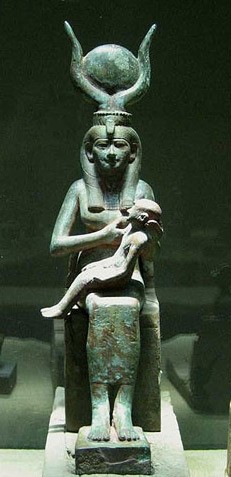
Notice the moon and horns on her head.
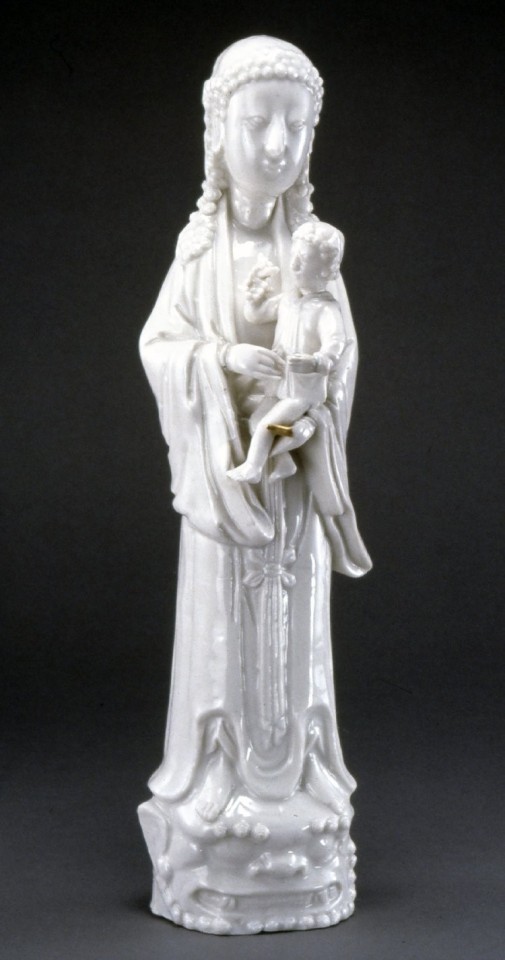

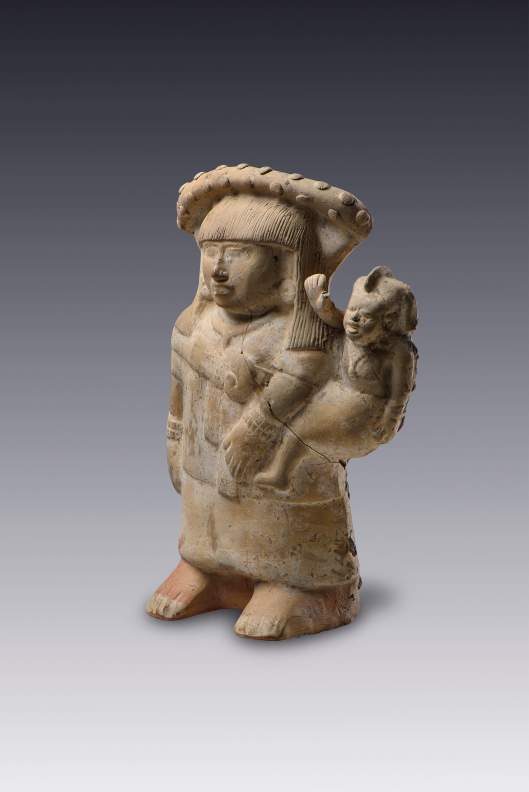
And last, but not least, the multiple figures of the Madonna and baby Jesus worshiped in devout catholic countries such as mine, specially the Black Madonnas all over Europe, which are very old, are nothing but representations of the same pagan mother goddess and son coming directly from Babylon, now adapted to the worship of Mary and baby Jesus.
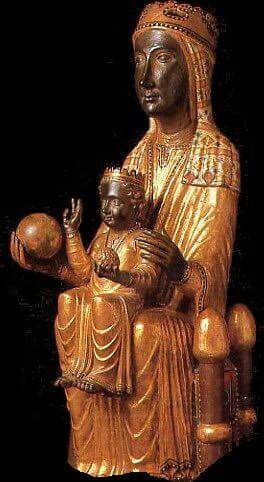
Satan pulled his scheme off very well and he had the whole world trapped into some form of Baal and mother goddess worship. The entire world had lapsed into polytheism (worship of many gods or idols). Mankind no longer desired to serve the true and living God and to accept His scriptural plan of salvation.
Around 2000 BC, in Abraham’s day, Baal worship and its pagan rites had so permeated the human race that God called Abraham out from it to be the progenitor of a nation of people (the Israelites or Jews) who would be instructed by God through Moses and the prophets to be a shining light and an example of godliness to the heathen nations and reveal to them God’s scriptural plan of salvation (Genesis 12:1-5; Exodus 19:5-6; Hebrews 11:8).
The Israelites were greatly blessed by God as His chosen people, who were to serve Him as His representatives of godliness to those heathen nations who had become entrapped by paganism, to evangelize those godless nations and to show them God’s love. The Israelites were repeatedly told that if they were to sin by serving other gods, to depart from the Lord and fail God in their mission as His representatives to those nations trapped in Baal worship, the Israelites would suffer terribly and be dispersed into all the nations of the earth.
Moses foretold that after his death the Israelites would disobey and turn to other “gods” to worship and serve them. After Moses’ death, Joshua took command and led the children of Israel across the river Jordan into Palestine. The Israelites were ordered to exterminate the Canaanites of the land because they were so wicked and so deeply involved in the evil practices of Baal worship, and to take the land as their dwelling to be used for the glory of God in leading the ungodly nations to God and His plan of redemption. The Israelites took the land and exterminated some of the inhabitants of the land but not all. The Israelites here had already begun to disobey God. They soon became weary in their conquests of Palestine and stopped fighting. Soon afterwards the Israelites departed from their worship of the Lord and started to worship and serve other gods as Moses had predicted. The children of Israel soon became so involved in Baal worship and its pagan practices that some of them even sacrificed their children to Satan.
Because of their disobedience to God’s command to be faithful in their worship of and service to the true and living God, the Israelites would have to suffer. On many occasions God allowed the children of Israel to be captured by their enemies and to be persecuted. When the Israelites cried out to God in sorrow for their sins, the Lord delivered them. The Lord raised up Judges to secure their deliverances. After each time the Lord brought about the deliverance of the captured, suffering children of Israel, the Israelites would plunge back into sin and Baal worship. As time passed the Israelites became even more involved in pagan worship despite God’s warnings and chastisements. God raised up prophets to warn the Israelites to repent or suffer more. Prophet after prophet was raised up for that purpose and many of them were executed by the Israelites.
In 722 BC, the ten Northern tribes were captured by the Assyrians and scattered abroad never to return, and in 586 BC the Babylonians captured Judah and Jerusalem. This was the third time Babylon came up against them, but this time brought about their total destruction as everything was torn down, including the first Jerusalem Temple, built by Salomon. After the Babylonian captivity, in 539 BC Babylon fell to the Persians, and the Persians granted the Jews exiled in Babylon permission to return to Jerusalem.
Many Jews (Israelites of the tribe of Judah) did return to Palestine during the years 539 BC, 457 BC, 445 BC, and after. In 70 AD the Romans, under General Titus, captured Jerusalem, destroyed it completely again, including the second Jerusalem Temple and massacred the Jews. All this had been foreseen by the prophet Daniel during the Babylonian captivity and was described in Daniel’s 70 weeks prophecy found in the Book of Daniel chapter 9, about which I will write in the future since it is extremely important. The Jews final dispersion or diaspora took place at this time. After 70 AD, the Jews had been dispersed into all the nations of the world to suffer. Nearly all nations who had received Jews eventually turned on them and persecuted them. The Jews have been the most hated and persecuted people in history and have suffered more than any other people. They disobeyed God and they had to suffer as God said they would.
The origin of Christmas and Easter
At the height of the Babylonian worship, when the cold season began every year, they believed their sun god was leaving them. It was on December 25th that they noticed the gradual return of the sun, the daylight hours starting to increase again after the winter solstice. So they called this day the birth of the sun. Tammuz was hailed as the son of the sun. He was idolized and even worshiped, and the first letter of his name became the symbol of sun worship. His birthday of December 25 was honored more and more. Satan worked many years before the conception and birth of the true Messiah to counterfeit, through sun worship, His miraculous conception and birth. Satan succeeded many times in leading God’s people, Israel, into sin and pagan sun worship.
The true date of the birth of Christ is most likely between July and September but since the exact date of Christ’s birthday was unknown, it was suggested by John Chrysostom, “Why not call it the same date as the birth of Tammuz, which was December 25?” This was the time when the sun had reached its lowest point on the horizon and started back up into the heavens and thus, the sun god had come to life, so to speak. So gradually December 25 came to be known as the birthday of Christ. The Papal Church finally instituted a special mass on that day, “Christ’s Mass,” and so December 25 became “Christmas.” The yule log burning in the fire followed by the green tree lit with candles all came from the pagan worship representing Nimrod being dead, while his spirit still lived on in the sun and was alive again in Tammuz, his son.
Jesus was crucified and resurrected near the spring equinox, a great festivity in honor of the goddess Ishtar. Satan was at work once again to bring the idea of having a celebration at the same time as the heathen but calling it “in honor of the Resurrection.” They also made cakes in honor of the moon goddess Semiramis, the so-called Queen of Heaven, which were round and on them was cut a cross in honor of the sun god. These cakes are called today “hot cross buns” in English speaking countries. In Jeremiah 7:16-18 it is described how God is speaking to the prophet denouncing this pagan practice.
The forty days of “weeping for Tammuz” became Lent and at the close of Lent came Easter Sunday. The prophet Ezekiel was shown even greater abominations. (Read Ezekiel 8:12-18). The goddess Ishtar, another name for Semiramis in Mesopotamia, came to be known as the goddess of springtime as in “new life,” or as history records it, the “goddess of reproduction.” The name Ishtar gave origin to the English term Easter. The pagans would go to some mountain side early Sunday morning and worship this goddess as the sun was rising in the east, and they gave themselves to immorality and indecency of every description. The eggs and rabbits were used as symbols of fertility and germination and hence “new life.” It all came into the Church gradually and was all blessed by the Catholic Church and given to the world. And some people wonder why God calls the Catholic Church Babylon in Revelation 17 (more about this in the next entry).
When Jesus died on the cross in the spring of the year 31 AD, Satan suffered a fatal blow. Any claim that he had had as ruler of the Earth was removed because he inflicted death upon a totally innocent victim, the Lamb of God, Jesus the Messiah; and this was witnessed by all the faithful angels who finally realized the true murderous character of Satan. This was his ultimate defeat, any strings of sympathy towards him that might have been left with the faithful angels were severed, and these angels realized that the only just fate for the chief rebel was death, total annihilation; which God will execute in its due time.
After his legal defeat at the cross, Satan’s kingdom of evil on earth started to be obliterated as well by the true followers of Messiah, who were spreading the good news of the Gospel of Christ throughout all the known world, converting pagans to the true worship of Yahweh, and eradicating the evil practices among these pagans. But Satan was not going to give up without a fight. He fiercely persecuted the early Church using the seat of his defeated kingdom on earth, the Roman Empire, who put to death millions of Christians in the first three centuries after Jesus’ ascension to heaven. But despite this cruel persecution, the Church grew exponentially, and spread to all the known world. The more Satan was trying to get rid of the Christian Movement, the Church, the more successful the Church was, and the more it grew. Satan had to change strategies, he stopped the open persecution, and instead he infiltrated the Church to destroy it from within.
He accomplished this by using his puppet in Rome, emperor Constantine, who before a major battle saw a strange vision in the sky of a cross and the words “In this sign you will conquer”, and thus converted to Christianity.
Satan devised a plan by which he would lay the foundation for and establish his own counterfeit church. Under Satan’s direction, paganism would get a new face. Satan would introduce to the world his own version of a “Christian Church.” The Caesars were worshiped as gods, and as the Roman Empire was near disintegration, the pagan Caesars did not want to lose their power in controlling the world, so they decided on a plan by which to keep their power and influence in the world. The Roman Caesars simply exchanged their Roman togas for religious costumes. Thus they could control the world’s governments and their economies through religion.
After Constantine defeated Maxentius in 312 A.D. in a battle for the throne of Rome, Satan continued in his clever plan to build his own version of a “Christian Church.” After his ascension to the Roman Throne, Constantine issued his Edict of Milan in 313 A.D. to stop the persecution of the true believers in Christ. Under Constantine, the Christian Church for a time found relief from persecution. Satan had now temporarily stopped his persecution of the Christian Church from without, but he would now proceed to attack the Church from within.
Constantine set up the Council of Nicaea and presided as “Pontifex Maximus”, a title carried by the roman Caesars as the maximum religious authority of the roman pagan religious system, and the official title of the Popes of our days; a title that cannot be found anywhere in the Bible because it comes straight from the Babylonian system of worship. Constantine’s job was to mix paganism with a perverted form of Christianity to make his new religious organization look respectable. This mixture of paganism with some of the teachings of Christ became Satan’s version of a “Christian Church.” This powerful religious institution would be later used by Satan to deceive millions and to cause the persecution and death of many authentic Bible believing Christians.
While enduring the early persecutions of the Roman government (65-300 A.D.), most of professing Christianity went through a gradual departure from New Testament doctrine concerning church government, worship and practice. Local churches ceased to be autonomous by giving way to the centralized control of “bishops” ruling over hierarchies. The simple form of worship from the heart was replaced with the rituals and splendor of paganism. Ministers became “priests,” and pagans became “Christians” by simply being sprinkled with water. This tolerance of an unregenerate membership only made things worse. PAGANISM with a veneer of Christianity is about the best definition for Roman Catholicism.
Constantine established himself as the head of the church around 313 A.D., which made this new “Christianity” the official religion of the Roman Empire. The first actual Pope in Rome was probably Leo I (440-461 A.D.), although some claim that Gregory I was the first (590-604 A.D.). This ungodly system eventually ushered in the darkest period of history known to man, properly known as the “Dark Ages” (500-1500 A.D.). Through popes, bishops, and priests, Satan ruled Europe, and Biblical Christianity became illegal. The Bible was taken from the hands of the people, and could only be read by the priests of the ruling “Church”, who were the only ones learned in Latin, the language of the empire, and the language of the predominant Bible version in western Europe, the Vulgate. Throughout all of this, however, there remained individual groups of true Christians, such as the Waldenses and the Anabaptists who would not conform to the Roman system, and who were fiercely persecuted by it.
One of the many departures from the true worship of Yahweh imposed by Constantine was the change of the day of rest from the biblical Sabbath, the seventh day of the week, Saturday, as prescribed by Yahweh God in Exodus 20:8-11. Although some Christians influenced by Babylonian paganism had already started observing Sunday instead of Saturday even before the rule of Constantine, it was him who finally made Sunday the official rest day of the new syncretic religion that he founded.
Church historian Socrates Scholasticus (5th century) wrote: “For although almost all churches throughout the world celebrate the sacred mysteries [of the Lord’s Supper] on the Sabbath of every week, yet the Christians of Alexandria and at Rome, on account of some ancient tradition, have ceased to do this.” – Socrates Scholasticus, Ecclesiastical History, Book 5, ch. 22.
Constantine was a sun worshiper during the first years of his reign. Later, he professed conversion to Christianity, but at heart remained a devotee of the sun. British historian Edward Gibbon says, “The Sun was universally celebrated as the invincible guide and protector of Constantine.” On March 7, 321, Sunday was declared the official day of rest. On that day markets were banned, and public offices were closed, except for the purpose of freeing slaves. There were, however, no restrictions on performing farming work, which was the work of the great majority of the population, on Sundays.
Many other changes to true Biblical Christianity took place in this Roman pagan church. Under Constantine, the pagans were permitted to bring their statues and idols of Semiramis, “The Queen of Heaven”, and Nimrod, “Baal”, “The Sun God’, into the Church. The names were simply changed to the Virgin Mary, who was now given the title of “Queen of Heaven” and little Jesus, “The Sun God.” For example: Is this Catholic image Mary and baby Jesus or is it Semiramis, “The Queen of Heaven” and son Nimrod/Tammuz?

Note the pagan trident symbol from the head of what is supposedly baby Jesus and that the hand is displayed with two fingers and a thumb prominent, being another way of symbolizing the trident, which is a Satanic hand sign symbolic of occult powers. This is also used by high Church officials and priests in blessings invoking the sign of the cross by motioning their right hand with two fingers and thumb casually extended. It is also found in freemasonry, which has origins that are common to the Catholic Church. The Catholic Church erroneously says that Peter was the first so called Pope of this Papal system but in fact it was really Constantine. So under Constantine as its first Pope, the Roman Catholic Institution as we know it today had its beginnings.
The Roman Catholic Church grew in power as her subjects were again under the priests and each succeeding Pope. Constantine had fifty Bibles made of perverted manuscripts composed by pagan worshipers of Baal from Alexandria. Alexandria was not only one of the seats of Baal worship but was also the headquarters of the most liberal philosophers. Those wicked philosophers produced their own perverted version of a Bible, and fifty such copies were made for Constantine to be given to the new “Church” over which he presided. The Latin Vulgate, authored by Jerome and based on the above fifty Bibles, later became the Roman Catholic Bible, which was kept from the people so that unscriptural traditions would have greater emphasis in the minds of the followers of the Pope.
Alexander Hislop in his book also traces Roman Catholic sacraments, the rosary beads, confessionals, the priesthood, etc. back to ancient Babylonian Baal worship. As a quick example, Hindus and Buddhists also use prayer beads, just like Catholics use rosaries; they’re called Japamala.
Roman Catholicism is based on ancient Babylonian Baal worship and on the man-made traditions of the Church fathers. Catholicism is not based on the teachings of God’s Word or on the Scriptural plan of salvation. It is nothing more that Satan’s attempt to co-opt and pervert true Christianity with his sun worship which was practiced on Sunday and that was initially most prevalent in Alexandria and Rome. From this pagan sun worship came both the trinity doctrine and Sunday worship. Too many people are too quick to write off the Fourth Commandment as unimportant when it obviously is.
Even Catholic officials as John Henry Cardinal Newman have admitted that their practices have their origin in paganism. This cardinal wrote as follows in his “Essay on the Development of Christian Doctrine” (1845): “The use of temples, and these dedicated to particular saints, and ornamented on occasions with branches of trees; incense, lamps, and candles; votive offerings on recovery from illness; holy water; asylums; holidays and seasons, use of calendars, processions, blessings on the fields; sacerdotal vestments, the tonsure, the ring in marriage, turning to the East, images at a later date, perhaps the ecclesiastical chant, and the Kyrie Eleison are all of pagan origin, and sanctified by their adoption into the Church.”
The Rev. John F. Sullivan wrote in his book “The Externals of the Catholic Church, Her Government, Ceremonies, Festivals, Sacramentals and Devotions” as follows: “It is interesting to note how often our Church has availed herself of practices which were in common use among pagans … Thus it is true, in a certain sense, that some Catholic rites and ceremonies are a reproduction of those of pagan creeds.”
Let’s see some examples of the pagan symbology that can be found everywhere in the RCC.
The god Dagon was an ancient Canaanite deity described in the Bible as the chief god of the Philistines, and who was represented as a fish deity. Dagon’s priests wore a hat representing the open mouth of a fish in honor of their god, and this is the origin of the miter, the hat wore by bishops and popes. Let’s see some photographs:
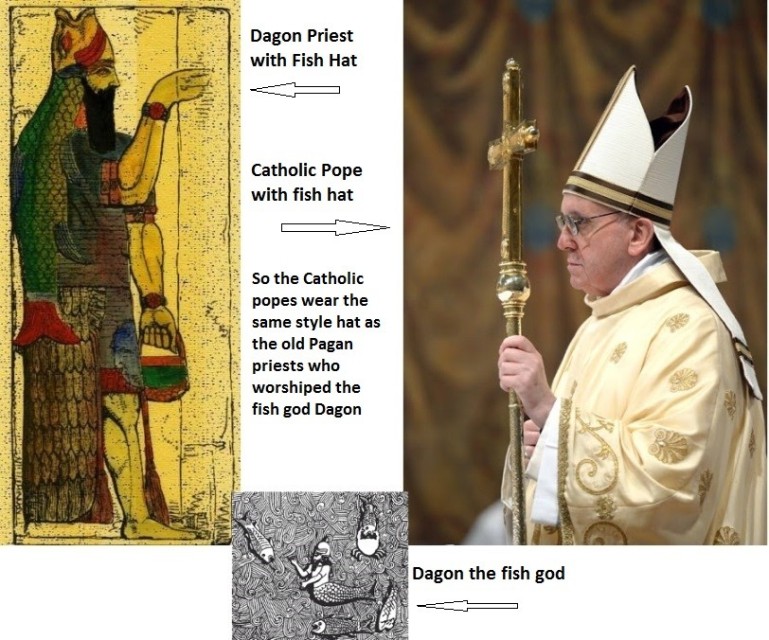
The Mesopotamian name for the sun god was Shamash (another representation of Nimrod), and his symbol can be seen in many places in Catholic priesthood vestments and symbology:
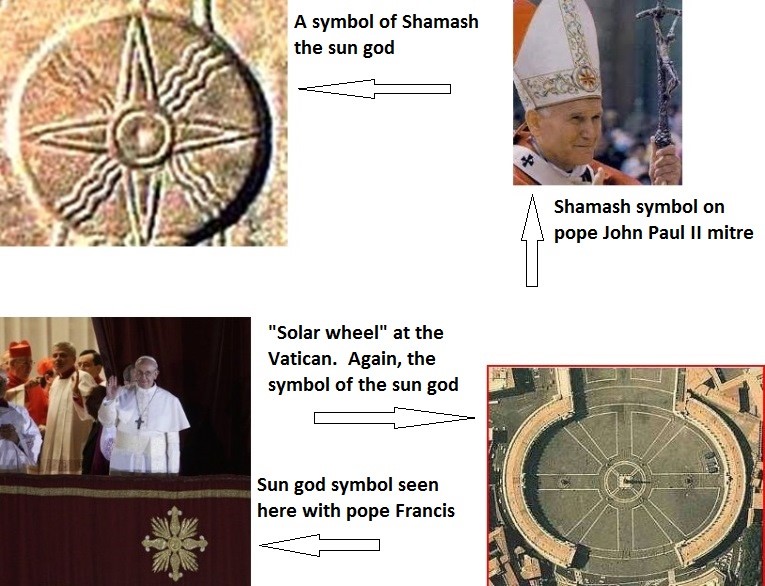
Here’s a picture of the Roman Catholic Monstrance, used to exhibit the host that is supposedly turned into the body of Jesus, with heavy sun symbology:

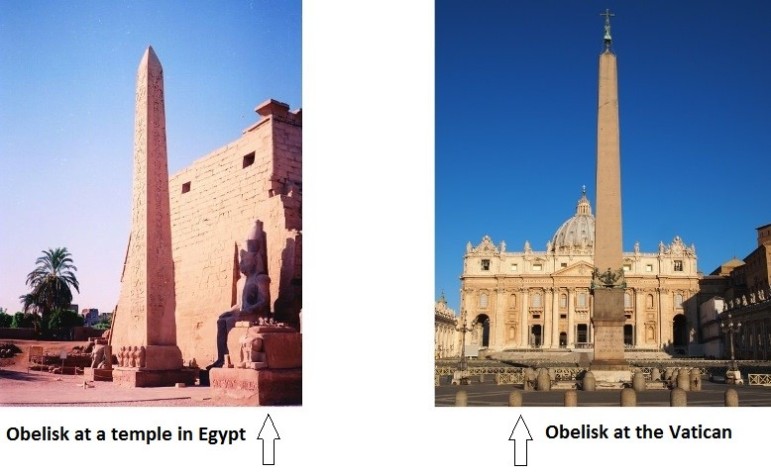
Another symbol that comes straight from Babylon is the Cross Pattée:
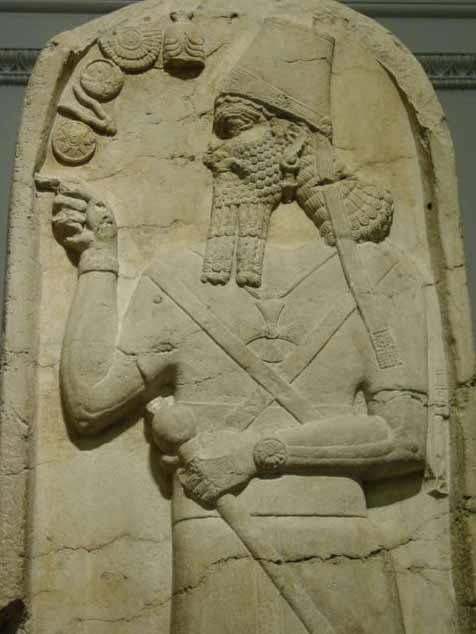
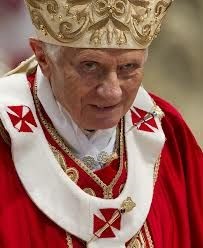
So there you have it my friends; the RCC is not Christian. It is Paganism disguised as Christianity, and it does not represent in the slightest true Christianity. Her fruits of child molestation by priests, persecution of bible believing Christians by the Inquisition, and millions of people turned off Christianity because they identify it with this monstrous system are not a coincidence. The Bible foretold the advent of this satanic counterfeit system hundreds of years before it happened, and this will be the subject of my next entry, where I will also expose who Antichrist is. The apostle Paul called it “The Great Apostasy”, and John the Revelator heard the voice of Jesus from Heaven in Revelation chapter 18 speaking to His people who are still caught in this system, and admonishing them as follows: “And I heard another voice from heaven, saying, Come out of her, my people, that ye be not partakers of her sins, and that ye receive not of her plagues.” (Rev. 18:4)
If you are a devout Catholic and have read thus far, I want you to know that I am not writing this out of hate for Catholics; on the contrary, I write out of love for you. I want you to know that we have been deceived all our life (I include myself because I grew up in this system and did not leave it until not long ago); that the time of the second coming of the Lord Jesus is approaching and that He wants you to come out of that system and worship Him in the simplicity of His Gospel, without the external form and pomp of the religious system that only pleases man, but not God. Peace unto you.
For more information, you can go to the following links:
http://www.eaec.org/cults/romancatholic.htm
http://www.end-times-prophecy.org/catholic-pagan.html
http://www.kotipetripaavola.com/catholicchurchbabylonianpaganroots.html
https://www.disclose.tv/the-roman-catholic-church-is-built-upon-pagan-sun-worship-321798
https://www.biblebelievers.com/jmelton/Catholic.html
http://ldolphin.org/semir.html
http://www.the-ten-commandments.org/origin_of_babylon_sun_worship.html
https://allthechildrenoflight.wordpress.com/tag/shing-moo/
Desmontando a la Iglesia Católica Romana, Parte II: Desenmascarando a Babilonia.
En la entrada anterior expuse siete puntos clave en los que las doctrinas de la Iglesia Católica Romana (ICR, para acortar) contradicen directamente las enseñanzas de las Sagradas Escrituras. ¿Cómo puede ser esto, cuando la ICR se jacta de ser la única Iglesia fundada por Jesucristo hace casi 2,000 años, y su cabeza, el Papa, el obispo de Roma, se declara como el representante de Jesucristo en la tierra, algo parecido a ser Dios en la tierra?
La ICR proclama que sus inicios se basan en Mateo 16:18, cuando Cristo supuestamente nombró primer Papa a Simón Pedro como resultado de la siguiente conversación:
15 El les dice: Y vosotros, ¿quién decís que soy?
16 Y respondiendo Simón Pedro, dijo: Tú eres el Cristo, el Hijo del Dios viviente.
17 Entonces, respondiendo Jesús, le dijo: Bienaventurado eres, Simón, hijo de Jonás; porque no te lo reveló carne ni sangre, mas mi Padre que está en los cielos.
18 Mas yo también te digo, que tú eres Pedro, y sobre esta piedra edificaré mi iglesia; y las puertas del infierno no prevalecerán contra ella.
19 Y á ti daré las llaves del reino de los cielos; y todo lo que ligares en la tierra será ligado en los cielos; y todo lo que desatares en la tierra será desatado en los cielos.
Cualquier estudiante sincero de las Escrituras descubre pronto la verdad sobre el significado del versículo 18 y sobre el apóstol Simón Pedro:
- La roca sobre la cual Jesucristo iba a construir Su Iglesia era Él mismo, no Pedro. Jesús cambió el nombre de Simón a Pedro (Cefas en arameo) cuando se conocieron por primera vez (Juan 1:42), no más tarde cuando Pedro hizo esta confesión de fe que Jesús era el Cristo en Mateo 16: 16-18. “Cefas” es el arameo equivalente a “Petros” en griego, de donde obtenemos “Pedro” en español. El término que Jesús usó para referirse a Pedro en el griego del NT es Petros, “Πέτρος”, que significa “una piedra”, o “una roca”, algo que se puede mover con las corrientes o con las dificultades. El término que usó en ese mismo versículo para referirse a la Roca fundamental de la Iglesia (y sobre esta piedra edificaré mi iglesia) es el griego Petra, “πέτρα”, que significa “una gran masa de roca”, algo que no se puede mover. Por lo tanto, Jesús estaba haciendo en ese verso una clara distinción entre Él mismo, la Roca inamovible, el cimiento de Su Iglesia, y Pedro, un humano que se convirtió en uno de los líderes de la Iglesia primitiva en Jerusalén, pero un ser humano que podía ser tambaleado e influenciado.
- Pedro fue uno de los líderes en la Iglesia primitiva y nunca fue reconocido como el que estaba por encima de todos los demás. En el Concilio de Jerusalén Pedro tomó parte en las conversaciones, pero al Apóstol Santiago, no Pedro, fue quien presidió y pronunció la decisión final del Concilio: “Cuando terminaron de hablar, Jacobo respondió, diciendo: Escuchadme, hermanos… Por tanto, yo juzgo…” (Hch.15:13, 19).
Los otros apóstoles no reconocían a Pedro como su jefe; de hecho, ellos lo enviaron a predicar en Samaria (no al revés): “Cuando los apóstoles que estaban en Jerusalén oyeron que Samaria había recibido la palabra de Dios, enviaron allá a Pedro y a Juan” (Hch. 8:14).
- El apóstol Pablo nunca creyó que Pedro fuera el líder de la Iglesia, de hecho, Pablo, que no era uno de los 12 apóstoles originales, reprendió severamente a Pedro en el capítulo 2 de Gálatas, cuando vio que Pedro se estaba comportando de manera hipócrita.
- Si Pedro era el líder, habría sido el deber de Pablo y los otros apóstoles reconocerlo como tal, respetarlo como jefe y enseñar en sus escritos que él era el jefe; pero ni los Evangelios, ni los Hechos de los Apóstoles, ni las Epístolas, ni Apocalipsis mencionan nada de esto.
Otro sobrecogedor descubrimiento que pronto hace el estudiante sincero y objetivo de las Escrituras y la Historia es que el origen y fundamento de la iglesia católica romana no es otro que la misteriosa religión pagana de la antigua Babilonia. Esta antigua religión es el origen de muchas de las Escuelas de Misterios, que son también el fundamento de la religión del antiguo Egipto, y que constituye la base de los sistemas de creencias de las sociedades secretas de hoy en día, como la Masonería y el Rosacrucismo. La base de este sistema de creencias es la adoración al sol, personalizada en la primera “santa trinidad” jamás adorada en la Tierra, la primera familia real de la antigua Babilonia: Nimrod, su esposa Semiramis y el hijo de ésta, Tammuz, como expuso Alexander Hislop en su notable libro de 1853, Las Dos Babilonias.
El rey Nimrod aparece en la Biblia en el capítulo 10 de Génesis, como el primer Rey de Babel, más tarde conocida como Babilonia, el primer imperio que reinó en la tierra después del diluvio de Noé. Solo ocho almas quedaron en esta tierra después del diluvio: Noé, su esposa, sus tres hijos, Sem, Cam y Jafet, y sus tres esposas. Todos los seres humanos en la tierra ahora mismo son descendientes de uno de los tres hijos de Noé, como lo demuestra la ciencia, tema sobre el que escribiré en el futuro, porque le da la puntilla a cualquier duda sobre la veracidad de la Biblia.
Después del diluvio, el enemigo de Dios y la humanidad, Satanás, de quien hablé en “El problema del mal, Parte II“, se vio derrotado por Dios, porque la única familia que quedaba en la Tierra, la familia de Noé, era adoradora del verdadero Dios Yahvé (o Jehová), y seguía sus leyes y preceptos. Pero pronto Satanás se afianzó de nuevo en contra de la humanidad pervirtiendo a uno de los hijos de Noé, Cam, y especialmente al hijo de Cam, Cus.
La posición de Satanás como enemigo de la humanidad tuvo su continuación después del diluvio en Babilonia con la construcción de la Torre de Babel en la llanura de Sinar, junto al río Éufrates, unas cuantas generaciones después del diluvio. En el momento de la construcción de Babilonia (Génesis 11: 1-4), la humanidad se había multiplicado y hablaba un solo idioma. Nimrod, era el hijo de Cus, que era el hijo de Cam, el hijo de Noé; por lo tanto, Nimrod era bisnieto de Noé. Cus ayudó a elucubrar con su hijo Nimrod un plan para gobernar a la humanidad a través de una religión falsificada. Nimrod fue el creador de la adoración al sol y fundador de Babilonia. Una traducción de la Biblia llamada el Tárgum dice así: “Nimrod se convirtió en un poderoso hombre de pecado, un asesino de hombres inocentes y un rebelde ante el Señor“.
El malévolo plan de Nimrod tuvo su origen en Babel, que más tarde se conoció como Babilonia. Esta ciudad de Babilonia con una torre “cuya cúspide pueda llegar hasta el cielo” fue construida por Nimrod (Génesis 10: 8-10; 11: 4). Llamaron a la torre “Babel, la puerta del cielo“, pero Dios lo llamó lo que realmente era, “Babel, confusión“, porque allí, Dios confundió el lenguaje de la humanidad, lo que los obligó a dispersarse. Este grupo de rebeldes quería un único gobierno que gobernara en el mundo y una única religión para influir en los corazones de la humanidad. Este fue el intento de Satanás de desafiar a Dios y a su autoridad, y el cabecilla de su plan fue Nimrod. Pero Dios descendió y detuvo esta rebelión mundial en Babel que desafiaba su mandato de que la humanidad repoblara la tierra (Génesis 9: 1), confundiendo su único lenguaje en muchos idiomas para que no pudieran entenderse los unos a los otros. La humanidad desistió de la construcción de Babel y se dispersaron a diferentes partes del mundo (Génesis 11: 8-9).
Sin embargo, Nimrod no fue disuadido de entretejer y fortalecer este malvado sistema religioso, así que se casó con su propia madre, Semiramis. Ella fue la primera reina deificada de Babilonia y Nimrod fue el primer rey deificado. Semiramis era tan malvada como su hijo Nimrod, y se había vendido a Satanás y a su culto tanto como él. El incesto fue usado como sistema para unir este nuevo falso sistema religioso. Nimrod y su madre / esposa iban a ser usados por Satanás en los siguientes siglos para crear todo sistema religioso falso en el planeta.
El plan de Satanás era desarrollar un sistema falsificado de religión de oposición para robarle la adoración al verdadero Dios del cielo, Yahvé. Este sistema falso tenía su propio sistema de sacrificios, así como Dios tenía un sistema de sacrificios. Pero la adoración pagana de Satanás requería la ofrenda de seres humanos, que a menudo eran los hijos e hijas de los adoradores. Un día santo falsificado fue instituido en honor del dios sol, (día del sol) y esto fue diseñado por Satanás para robarle a Dios su peculiar autoridad como Creador del universo como está designado en su día santo, el Sábado.
Los seguidores de Nimrod y Semiramis se hundieron tan profundamente en el pecado y el ocultismo que incluso sacrificaban bebés a Satanás en su adoración a él. Esto se convirtió en práctica común hasta que Sem, uno de los tres hijos de Noé y tío abuelo de Nimrod, en su ira, mató a Nimrod y lo despedazó como ejemplo para que otros no cometieran tan abominables pecados y no siguieran esas malvadas prácticas religiosas. Sem era un hombre piadoso y de su linaje vendría Jesús el Mesías.
Alexander Hislop declaró en Las Dos Babilonias: “la Torre de Babel era en realidad la adoración a Satanás en forma de fuego, el sol y la serpiente. Sin embargo, la adoración a Satanás no podía hacerse abiertamente debido a los muchos que todavía creían en el verdadero Dios de Noé. Así que en Babel comenzó una religión de misterio donde Satanás podía ser adorado en secreto“.
Debido a la muerte de Nimrod, sus seguidores estaban estupefactos y doloridos. Su héroe estaba muerto. Tenían miedo de continuar en su adoración a Satanás por temor a correr la misma suerte de Nimrod, por lo que se estableció una religión de misterio en Babel donde Satanás podía ser adorado en secreto. Esto es exactamente lo que está sucediendo en estos últimos días. Satanás está usando misterios y trucos para engañar a las personas y que éstas piensen que están adorando a Dios cuando en realidad lo están adorando a él (ya hablaré más en otra entrada sobre ésto).
Por un corto intervalo, las prácticas de esta religión falsificada cesaron, pero Semiramis, la esposa de Nimrod, tuvo una brillante idea para revivir con éxito la religión pagana de Nimrod y darle una nueva forma. Poco después de la muerte de su marido, Semiramis quedó embarazada. Ella anunció que cuando Nimrod murió, éste ascendió al sol y el sol se convirtió en un símbolo de Nimrod. Semiramis le dijo a la gente que un rayo de sol se le había acercado y la había embarazado con un niño y que en realidad el niño era Nimrod que regresaba en una reencarnación del dios del sol. El niño fue llamado Tammuz y estos tres, Nimrod, Semiramis y Tammuz fueron adorados como la personificación del dios sol, y es aquí donde se originó la doctrina trinitaria de los tres en uno. Esta religión de misterio no era más que la adoración de Satanás. Leed sobre los orígenes paganos de la doctrina de la trinidad para más información.
“La trinidad comenzó en la antigua Babilonia con Nimrod – Tammuz – y Semiramis. Semiramis exigió adoración tanto para su esposo y su hijo, como para ella misma. Afirmó que su hijo, era tanto el padre como el hijo. Sí, él era “dios el padre” y “dios el hijo” – “La primera trinidad divina incomprensible.” – Las Dos Babilonias; Alexander Hislop, p.51
Semiramis proclamó que su esposo Nimrod era un dios, y ella, como esposa de Nimrod, era una diosa. Luego se declaró a sí misma como “La Reina del Cielo” y que debía ser adorada como tal. Afirmó que su espíritu era la luna y que cuando ella muriera moraría en la luna, igual que Nimrod que estaba ya en el sol. ¡Qué diabólico esperpento inspirado por Satanás!
Satanás estaba sentando las bases de todo sistema de falsedad y error que el mundo jamás ha conocido. Tomaron la verdad de Dios y la convirtieron en una mentira y “adoraron y sirvieron a la criatura (incluso a Satanás) más que al Creador” (Romanos 1:25). Este sistema de paganismo, mientras que profesa ser la verdadera religión, es en realidad la adoración del diablo. Profesa y afirma ser la verdad de Dios, pero en realidad, es la obra maestra de Satanás, el “misterio de iniquidad“.
A medida que la iglesia de Satanás ganaba impulso, Semiramis empujó a esta orden religiosa satánica a la clandestinidad. Los seguidores de esta religión falsificada tenían que prestar juramentos secretos; de esta manera tuvieron sus comienzos las sociedades secretas (las logias masónicas de hoy en día). Se establecieron los confesionarios y el sacerdocio. Los seguidores de esta religión pagana confesaban sus pecados a sus sacerdotes (¿qué iglesia continuó esta tradición pagana no bíblica?). De esta manera, Semiramis podía controlar a sus seguidores y ejercer su señorío sobre ellos. Semiramis, audaz y descaradamente, proclamó que ella y sus sacerdotes eran los únicos que entendían los misterios de Dios y que eran el único camino posible hacia Dios. Debido a su dedicación y al temor de este falso sistema religioso, los seguidores de esta religión cumplían sumisamente.
Semiramis y sus sacerdotes de Satanás estaban profundamente inmersos en el ocultismo y la magia. Eran maestros de la mentira y el engaño. Había estatuas e ídolos de este culto madre/hijo por todas partes. Semiramis pronto fue aclamada como “La Reina del Cielo” (Astarté). Su símbolo se convirtió en la luna y su marido Nimrod fue llamado “Baal” (el “dios del sol”), y su símbolo se convirtió en el sol. La ciudad de Babilonia fue la sede de la adoración de Satanás hasta su caída por los medos y los persas en el 539 a.C. En este momento los sacerdotes paganos de Babilonia se marcharon de allí y fueron a Alejandría y Pérgamo.
Cabe señalar que la mayoría de los sacerdotes paganos de Babilonia fueron a Pérgamo más que a Alejandría, por lo que durante muchos siglos después de la caída de Babilonia, Pérgamo se convirtió en la nueva sede de Satanás, como dijo Cristo en Apocalipsis 2: 12-13; pero alrededor del 129 a.C., se les presentó la oportunidad de abandonar Pérgamo e ir a Roma, por lo que Roma se convirtió en la sede final de Satanás, donde estableció su iglesia de adoración al sol, y allí sigue hasta hoy.
La adoración a Baal estaba en pleno apogeo; se popularizó rápidamente y se extendió a muchas partes del mundo. En Egipto, a Semiramis se la conocía como “Isis”, “La Reina del Cielo”. Nimrod se hizo conocido como “Osiris”, el esposo / hijo, y con frecuencia llamado “Horus” (el dios del sol). En Fenicia, Semiramis y Nimrod fueron adorados como como Astoret y Tammuz; en Grecia, Afrodita y Eros; en Roma, Venus y Cupido, y en China, la Madre Xiwangmu y su hijo.
Veamos algunos ejemplos del culto a la madre / hijo (Semiramis / Tammuz), que data mucho antes que el cristianismo, por todo el mundo:
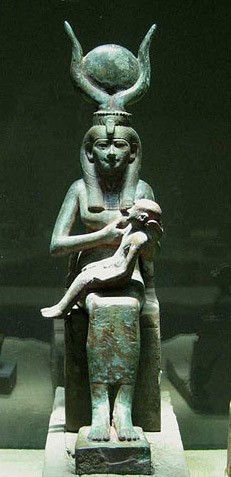
Observad la luna y los cuernos sobre su cabeza.

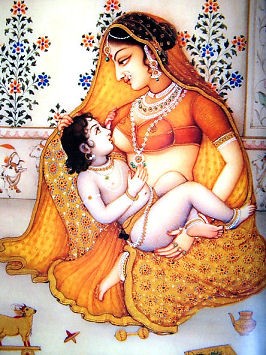

Y por último, pero no por ello menos importante, las múltiples figuras de la Virgen y el niño Jesús adoradas en países católicos devotos como el mío, especialmente las antiquísimas Vírgenes Negras, que están por toda Europa, no son más que representaciones de la misma diosa madre pagana e hijo, que provienen directamente de Babilonia, ahora adaptadas a la adoración de María y el niño Jesús:
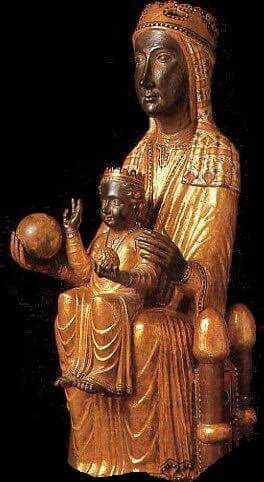
Satanás desarrolló su plan magistralmente y consiguió tener a todo el mundo atrapado en algún tipo de adoración a Baal y a la diosa madre. El mundo entero cayó en el politeísmo (adoración a muchos dioses o ídolos). La humanidad ya no deseaba servir al Dios viviente y verdadero y aceptar su plan de salvación de acuerdo con las Escrituras.
Alrededor del año 2000 a.C., en la época de Abraham, la adoración a Baal y sus ritos paganos impregnaron tanto a la raza humana que Dios llamó a Abraham para que fuera el progenitor de un pueblo o nación (los israelitas) que serían instruidos por Dios a través de Moisés y los profetas para que fuesen una luz brillante y un ejemplo de piedad y devoción para las naciones paganas, y les revelasen el plan de salvación bíblico de Dios (Génesis 12: 1-5; Éxodo 19: 5-6; Hebreos 11: 8).
Los israelitas fueron bendecidos grandemente por Dios como su pueblo elegido y debían servirle como sus piadosos representantes ante las naciones paganas que habían quedado atrapadas en la idolatría, para evangelizar a esas naciones impías y mostrarles el amor de Dios. Los israelitas fueron advertidos repetidamente que, si pecaban sirviendo a otros dioses, si se apartaban del Señor y le fallaban a Dios en su misión como representantes ante esas naciones atrapadas en la adoración de Baal, sufrirían terriblemente y serían dispersos por todas las naciones de la tierra.
Moisés predijo que después de su muerte, los israelitas desobedecerían la advertencia y se volverían a otros “dioses” para adorarlos y servirlos. Después de la muerte de Moisés, Josué tomó el mando y llevó a los hijos de Israel a través del río Jordán hacia Palestina. Los israelitas fueron ordenados que exterminasen a los cananeos moradores de la tierra porque eran muy perversos y estaban profundamente involucrados en prácticas satánicas del culto a Baal, y que tomasen la tierra como su nueva morada y la usasen para la gloria de Dios guiando a las naciones impías hacia Dios y su plan de redención. Los israelitas tomaron la tierra y exterminaron a algunos de los habitantes, pero no a todos. Aquí ya habían comenzado los israelitas a desobedecer a Dios. Pronto se cansaron de sus conquistas en Palestina y dejaron de luchar. Poco después, los israelitas dejaron de adorar a Yahvé y comenzaron a adorar y servir a otros dioses como Moisés había predicho. Los hijos de Israel pronto se involucraron tanto en el culto a Baal y sus prácticas paganas que algunos de ellos incluso sacrificaban sus hijos a Satanás.
Debido a su desobediencia al mandato de Dios de ser fieles en su adoración y servicio al Dios viviente y verdadero, los israelitas tendrían que sufrir. En muchas ocasiones, Dios permitió que los hijos de Israel fueran capturados por sus enemigos y perseguidos. Cuando el pueblo de Israel clamaba a Dios en angustia por sus pecados, el Señor los libraba. Yahvé elevó a jueces para asegurar sus múltiples liberaciones. Cada vez que Dios intervenía para la liberación de los hijos de Israel, cautivos y bajo grandes sufrimientos, los israelitas volvían a hundirse en el pecado y adoración a Baal. Con el paso del tiempo, los judíos se hundieron aún más en la adoración pagana a pesar de las advertencias y los castigos de Dios. Dios les envió profetas para advertirles y que se arrepintiesen o si no sufrirían aún más. Profeta tras profeta fue enviado para ese propósito y muchos de ellos fueron ejecutados por Israel.
En 722 a.C. las diez tribus del norte fueron capturadas por los asirios y dispersadas en el extranjero para nunca regresar, y en 586 a.C. los babilonios capturaron a Judá y Jerusalén. Esta era la tercera vez que Babilonia se enfrentaba a ellos, pero esta vez conllevó su destrucción total ya que la ciudad de Jerusalén fue arrasada entera, incluido el primer Templo de Jerusalén, construido por Salomón. Después del cautiverio babilónico, en el 539 a.C., Babilonia cayó ante los persas, y éstos les concedieron a los judíos en el exilio en Babilonia permiso para regresar a Jerusalén.
Muchos judíos (israelitas de la tribu de Judá) regresaron a Palestina durante los años 539 a.C., 457 a.C., 445 a.C., y después. En el 70 d.C., los romanos, bajo el general Tito, capturaron Jerusalén, la destruyeron completamente de nuevo, incluido el Segundo Templo de Jerusalén y masacraron a los judíos. Todo esto había sido vaticinado por el profeta Daniel durante el cautiverio babilónico y fue descrito en su profecía de las 70 semanas que se encuentra en el capítulo 9 del Libro de Daniel, sobre la cual escribiré en el futuro porque es importantísima. La dispersión final de los judíos o diáspora tuvo lugar en este momento. Después del 70 d.C., los judíos fueron dispersados por todas las naciones del mundo con gran sufrimiento. Casi todas las naciones que habían recibido judíos finalmente se volvieron contra ellos y los persiguieron. Los judíos han sido el pueblo más odiado y perseguido de la historia y han sufrido más que cualquier otro grupo étnico. Desobedecieron a Dios y sufrieron las consecuencias, como Dios dijo que sucedería.
El origen de la Navidad y la Pascua.
En el apogeo de la adoración babilónica, cuando comenzaba la estación invernal todos los años, los paganos creían que su dios sol los estaba abandonando. Era el 25 de diciembre cuando empezaban a notar el regreso gradual del sol, y las horas de luz comenzaban a aumentar nuevamente después del solsticio de invierno. De esta manera, llamaron a este día el nacimiento del sol. Tammuz fue aclamado como el hijo del sol. Fue idolatrado e incluso adorado, y la primera letra de su nombre se convirtió en el símbolo de la adoración al sol. Su cumpleaños del 25 de diciembre fue honrado cada vez más. Satanás trabajó durante muchos años antes de la concepción y el nacimiento del verdadero Mesías para falsificar, a través de la adoración al sol, su concepción milagrosa y su nacimiento. Satanás logró muchas veces llevar al pueblo de Dios, Israel, al pecado y a la adoración pagana del sol.
La verdadera fecha del nacimiento de Cristo cae muy probablemente entre julio y septiembre, pero como se desconocía la fecha exacta del cumpleaños de Cristo, Juan Crisóstomo hizo la siguiente sugerencia: “¿Por qué no ponerlo en la misma fecha que el nacimiento de Tammuz, que fue el 25 de diciembre?” Este fue el momento en que el sol había alcanzado su punto más bajo en el horizonte y comenzaba a subir en los cielos y, por lo tanto, el dios del sol había cobrado vida, por así decirlo. Entonces, gradualmente, el 25 de diciembre llegó a ser conocido como el cumpleaños de Cristo. La Iglesia Papal finalmente instituyó una misa especial en ese día, “la Misa de Cristo”, o “Christ´s Mass” en inglés y así, el 25 de diciembre se convirtió en la “Navidad“. El madero de navidad, tradición del norte de Europa, que ardía en el fuego junto al árbol verde iluminado con velas, provienen del culto pagano que representaba a Nimrod muerto, mientras su espíritu aún vivía en el sol y revivía nuevamente en Tammuz, su hijo.
Jesús fue crucificado y resucitó cerca del equinoccio de primavera, que era un gran festival en honor de la diosa Ishtar. Satanás concibió de nuevo una celebración al mismo tiempo que la de los paganos, pero llamándola “en honor a la Resurrección“. Los paganos también hacían pasteles en honor a la diosa de la luna, Semiramis, la llamada Reina del Cielo; estos pasteles eran redondos y sobre ellos se cortaba una cruz en honor al dios sol. Estos pasteles se denominan hoy “hot cross buns” en países de habla inglesa. En Jeremías 7: 16-18 se describe cómo Dios le habla al profeta en denuncia de esta práctica pagana.
Los cuarenta días de “llanto por Tammuz“ se convirtieron en la Cuaresma, y al final de la Cuaresma llegaba el domingo de Pascua. Al profeta Ezequiel se le mostraron abominaciones aún mayores (leed Ezequiel 8: 12-18). La diosa Ishtar, otro de los nombres de Semiramis en Mesopotamia, llegó a ser conocida como la diosa de la primavera o de la “nueva vida“, o, como la historia registra, la “diosa de la procreación“. El nombre de Ishtar dio origen al término inglés Easter, que es el vocablo utilizado en este idioma para la Pascua. Los paganos iban a la ladera de alguna montaña el domingo por la mañana y adoraban a esta diosa mientras el sol salía en el este, y se entregaban a inmoralidad e indecencia de toda índole. Los huevos y los conejos se utilizaban como símbolos de fertilidad y germinación y, por lo tanto, de “nueva vida“. Todo esto se infiltró en la Iglesia gradualmente y fue bendecido por la Iglesia Católica y extendido por el mundo. Y algunos se preguntarán porqué Dios llama a la Iglesia Católica Babilonia en Apocalipsis 17 (más sobre esto en la próxima entrada).
Cuando Jesús murió en la cruz en la primavera del año 31 d.C., Satanás sufrió un golpe mortal. Cualquier reivindicación que hubiera tenido como soberano de la Tierra fue invalidada al infligir la muerte a una víctima totalmente inocente, el Cordero de Dios, Jesús el Mesías; y esto fue presenciado por todos los ángeles fieles que finalmente se dieron cuenta del verdadero carácter asesino de Satanás. Esta fue su derrota definitiva; cualquier sentimiento de simpatía hacia él que pudiera haber quedado en los ángeles fieles se desvaneció definitivamente, y estos ángeles se dieron cuenta de que el único final justo para el jefe de los rebeldes era la muerte, su aniquilación total; que Dios ejecutará a su debido tiempo.
Después de su derrota legal en la cruz, el reino maligno de Satanás en la tierra también comenzó a ser destruido por los verdaderos seguidores del Mesías, quienes difundieron las buenas nuevas del Evangelio de Cristo por todo el mundo conocido, convirtiendo a los paganos al verdadero culto de Yahvé, y erradicando las prácticas perversas entre estos paganos. Pero Satanás no iba a rendirse sin luchar. Persiguió ferozmente a la Iglesia primitiva utilizando la sede de su derrotado reino en la tierra, el Imperio Romano, que mató a millones de cristianos en los primeros tres siglos después de la ascensión de Jesús al cielo. Pero a pesar de esta cruel persecución, la Iglesia crecía exponencialmente y se extendió a todo el mundo conocido. Cuanto más intentaba Satanás deshacerse del movimiento cristiano, la Iglesia, más éxito tenía ésta y más crecía. Satanás tuvo que cambiar de estrategia, detuvo la persecución frontal y se infiltró en la Iglesia para destruirla desde dentro.
Logró ésto usando a su títere en Roma, el emperador Constantino, quien antes de una gran batalla vio una extraña visión en el cielo de una cruz y las palabras “En este signo conquistarás“, y así se convirtió al cristianismo.
Satanás ideó un plan mediante el cual sentaría las bases y establecería su propia iglesia falsificada. Bajo su dirección, el paganismo tendría una nueva cara. Satanás presentaría al mundo su propia versión de una “Iglesia Cristiana”. Los Césares eran adorados como dioses, y cuando el Imperio Romano estaba cerca de la desintegración, los Césares paganos no querían perder su control del mundo conocido, así que elaboraron un plan para cual mantener su poder e influencia en el mundo. Los Césares romanos simplemente cambiaron sus togas romanas por vestimentas religiosas. Así podrían controlar los gobiernos del mundo y sus economías a través de la religión.
Después de que Constantino derrotara a Majencio en 312 d.C. en una batalla por el trono de Roma, Satanás continuó con su inteligente plan para construir su propia versión de una “Iglesia Cristiana”. Después de su ascenso al trono romano, Constantino emitió su Edicto de Milán en 313 d.C. para detener la persecución de los verdaderos creyentes en Cristo. Bajo Constantino, la iglesia cristiana fue aliviada de la persecución durante un tiempo. Satanás había detenido temporalmente su persecución contra la Iglesia cristiana, pero ahora procedería a atacar a la Iglesia desde adentro.
Constantino convocó el Concilio de Nicea y presidió como “Sumo Pontífice“, un título que los Césares romanos tenían como la máxima autoridad religiosa del sistema religioso pagano romano, y el título oficial de los Papas de nuestros días; un título que no se puede encontrar en ninguna parte de la Biblia porque proviene directamente del sistema de adoración de Babilonia. El papel de Constantino fue el de mezclar el paganismo con una forma pervertida del cristianismo para hacer que su nueva organización religiosa pareciera respetable. Esta mezcla de paganismo con algunas de las enseñanzas de Cristo se convirtió en la versión de Satanás de la “Iglesia Cristiana”. Esta poderosa institución religiosa sería luego utilizada por Satanás para engañar a millones y causar la persecución y la muerte de muchos cristianos auténticos creyentes en la Biblia.
Mientras aguantaba las primeras persecuciones del gobierno romano (65-300 d.C.), la mayor parte del cristianismo profesante pasó por una desviación gradual de la doctrina del Nuevo Testamento en cuanto al gobierno de la iglesia, la adoración y las prácticas. Las iglesias locales dejaron de ser autónomas dando paso al control centralizado de los “obispos” que gobernaban sobre jerarquías. La simple forma de adoración desde el corazón fue reemplazada por los rituales y el esplendor del paganismo. Los ministros se convirtieron en “sacerdotes” y los paganos se convirtieron en “cristianos” simplemente al ser rociados con agua. Esta tolerancia de miembros no regenerados por el auténtico evangelio solo empeoró las cosas. La mejor definición del Catolicismo Romano es PAGANISMO con una apariencia superficial de cristianismo.
Constantino se estableció como la cabeza de la iglesia alrededor del año 313 d.C., lo que convirtió a este nuevo “cristianismo” en la religión oficial del Imperio Romano. El primer Papa así denominado en Roma fue probablemente León I (440-461 d.C.), aunque algunos afirman que Gregorio I fue el primero (590-604 A.D.). Este sistema impío marcó el comienzo del período más oscuro de la historia conocido por el hombre, la conocida como Alta Edad Media o también como “Edad Oscura” (500-1500 dC). A través de los papas, obispos y sacerdotes, Satanás gobernó Europa y el cristianismo bíblico fue proscrito. La Biblia fue tomada de las manos de la gente y solo podía ser leída por los sacerdotes de la “Iglesia” gobernante, que eran los únicos que aprendían el latín, el idioma del imperio y el idioma de la versión bíblica predominante en Europa occidental, la Vulgata. A lo largo de todo esto, sin embargo, quedaron grupos individuales de cristianos verdaderos, como los Valdenses y los Anabaptistas que no se sometieron al sistema romano, y que fueron perseguidos ferozmente por él.
Una de las muchas desviaciones de la verdadera adoración de Yahvé impuesta por Constantino fue el cambio del día de descanso bíblico del Sabbath, el séptimo día de la semana, el Sábado, según lo prescrito por Yahvé Dios en Éxodo 20: 8-11. Aunque algunos cristianos, influenciados por el paganismo babilónico, ya habían comenzado a observar el domingo en lugar del sábado incluso antes del gobierno de Constantino, fue él quien finalmente hizo del domingo el día oficial de descanso de la nueva religión sincrética que él fundó.
El historiador eclesiástico Sócrates el Escolástico (siglo V) escribió: “Aunque casi todas las iglesias por todo el mundo celebran los sagrados misterios [de la Cena del Señor] en el sábado de cada semana, sin embargo, los cristianos de Alejandría y Roma, a causa de alguna antigua tradición, han dejado de hacer esto“. – Sócrates Escolástico, Historia Ecclesiastica, Libro 5, cap. 22.
Constantino fue adorador del sol durante los primeros años de su reinado. Más tarde, profesó la conversión al cristianismo, pero en el fondo seguía siendo un devoto del sol. El historiador británico Edward Gibbon escribió: “El Sol fue universalmente celebrado como el guía invencible y protector de Constantino“. El 7 de marzo de 321, el Domingo, el día del sol, dies Solis (Sun-day en inglés) fue declarado como día oficial de descanso. Ese día, los mercados fueron prohibidos, y las oficinas públicas fueron cerradas, excepto con el propósito de liberar esclavos. Sin embargo, los domingos no se impusieron restricciones a la realización de trabajos agrícolas, que era la ocupación de la gran mayoría de la población.
Muchos otros cambios al verdadero cristianismo bíblico tuvieron lugar en esta iglesia pagana de Roma. Bajo Constantino, a los paganos se les permitió traer sus estatuas e ídolos de Semiramis, “La Reina del Cielo”, y Nimrod, “Baal”, “El Dios del Sol”, a la Iglesia. Los nombres simplemente se cambiaron por los de la Virgen María, que recibió entonces el título de “Reina del cielo” y del pequeño Jesús, “El dios del sol”. Por ejemplo: ¿Es esta imagen católica María y el niño Jesús o es Semiramis, la ”Reina del Cielo” y su hijo Nimrod / Tammuz?

Observad el símbolo del tridente pagano sobre la cabeza de quien supuestamente es el niño Jesús, y que la mano se muestra con dos dedos y un pulgar prominente, siendo otra forma de simbolizar el tridente, que es un signo satánico simbólico de los poderes ocultos. Este símbolo también es usado por altos dignatarios de la Iglesia y sacerdotes en bendiciones que invocan el signo de la cruz moviendo la mano derecha con dos dedos y el pulgar extendido, casualmente. También se encuentra este símbolo en la masonería, que tiene orígenes que son comunes a la Iglesia Católica. La Iglesia Católica dice erróneamente que Pedro fue el primer Papa de este sistema, pero en realidad fue Constantino. De modo que, bajo Constantino como su primer Papa, la institución católica romana, tal y como la conocemos hoy, tuvo sus comienzos.
La Iglesia Católica Romana incrementó su poder al encontrarse sus feligreses nuevamente bajo la tutela de sacerdotes y de cada subsiguiente Papa. Constantino mandó publicar cincuenta Biblias compuestas de manuscritos corruptos escritos por adoradores paganos de Baal en Alejandría. Alejandría no solo fue una de las sedes del culto de Baal, sino también la sede de los filósofos más liberales. Estos perversos filósofos produjeron su propia versión corrupta de la Biblia, y se hicieron cincuenta copias para que Constantino se las entregara a la nueva “Iglesia” que él presidía. La Vulgata latina, escrita por Jerónimo de Estridón y basada en las cincuenta Biblias anteriores, se convirtió más tarde en la única Biblia católica romana, que se guardó de la gente para que las tradiciones no bíblicas tuvieran mayor énfasis en la mente de los seguidores del Papa.
En su libro, Alexander Hislop sigue la pista también de los sacramentos católicos romanos, los rosarios, los confesionarios, el sacerdocio, etc., hasta el antiguo culto de Baal en Babilonia. Otro ejemplo de esto: los hindúes y budistas también usan cuentas para rezar, al igual que los católicos usan rosarios; se les llama Yapa mala.
El catolicismo romano se basa en el antiguo culto babilónico a Baal y en tradiciones humanas creadas por los padres de la Iglesia. El catolicismo no se basa en las enseñanzas de la Palabra de Dios o en el plan bíblico de salvación. No es otra cosa que el intento de Satanás de infiltrar y pervertir el verdadero cristianismo con su adoración al sol, practicada los domingos y que inicialmente fue prevalente sólo en Alejandría y Roma. De esta adoración pagana al sol vinieron tanto la doctrina de la trinidad como la adoración en domingo. Demasiadas personas descartan alegremente el Cuarto Mandamiento como algo poco importante cuando obviamente lo es.
Incluso altos jerarcas católicos como el cardenal John Henry Newman han admitido que sus prácticas tienen origen en el paganismo. Este cardenal escribió lo siguiente en su obra “Meditaciones sobre el Desarrollo de la Doctrina Cristiana” (1845): “El uso de templos dedicados a santos particulares y adornados en ocasiones con ramas de árboles, incienso, lámparas y velas; las ofrendas para la sanación de enfermedades, el agua bendita, los asilos, los días festivos y las temporadas litúrgicas, el uso de calendarios, las procesiones, las bendiciones en los campos, las vestiduras sacerdotales, las tonsuras, los anillos en el matrimonio, el girarse hacia el Este, las imágenes en fechas posteriores, quizás el canto eclesiástico y el Kyrie Eleison son todos de origen pagano y santificados por su adopción en la Iglesia“.
El reverendo John F. Sullivan escribió en su libro “Las Formas Externas de la Iglesia Católica, su Gobierno, Ceremonias, Festivales, Sacramentales y Devociones” lo siguiente: “Es interesante observar con qué frecuencia nuestra Iglesia se ha valido de prácticas que fueron de uso común entre los paganos … Por lo tanto, es cierto, en cierto sentido, que algunos ritos y ceremonias católicas son una reproducción de los credos paganos“.
Veamos algunos ejemplos de simbología pagana que puede encontrarse por todas partes en la ICR.
El dios Dagón era una antigua deidad cananea descrita en la Biblia como el principal dios de los filisteos, y que estaba representado como una deidad con forma de pez. Los sacerdotes de Dagón llevaban un tocado que representaba la boca abierta de un pez en honor a su dios, y este es el origen de la mitra, el tocado que llevan los obispos y papas. Veamos algunas fotografías:
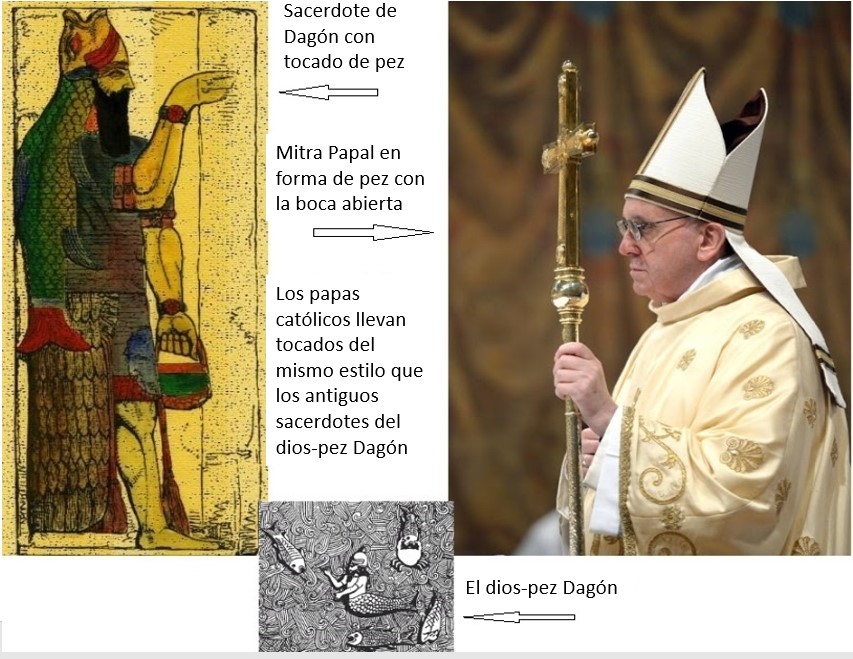
El nombre mesopotámico del dios sol era Shamash (otra representación de Nimrod), y su símbolo se puede ver en muchos lugares en la vestimenta y simbología del sacerdocio católico:
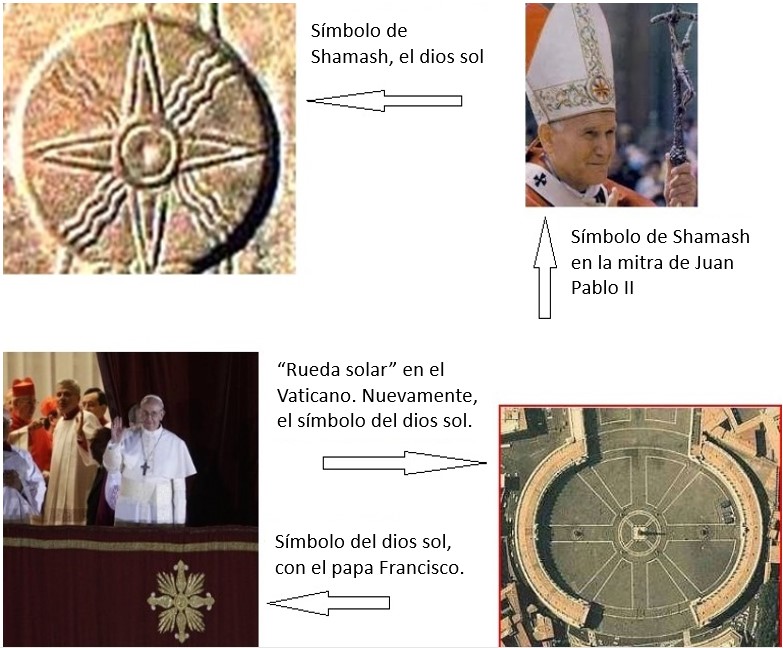
Aquí os muestro una imagen de la custodia católica romana, que se utiliza para exhibir la hostia que supuestamente se convierte en el cuerpo de Jesús, con una fuerte simbología del sol:
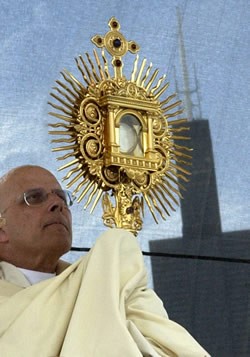

Otro símbolo que viene directamente de Babilonia es la Cruz Patada:
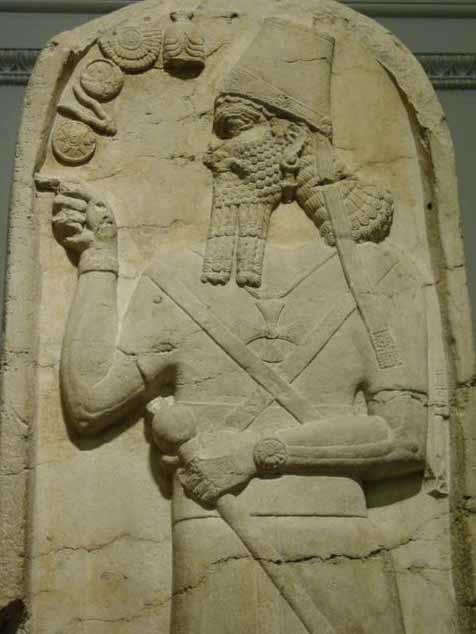

Los ejemplos son demasiado numerosos para ponerlos a todos en una entrada de blog, pero quiero alentar al buscador sincero de la verdad a investigar más a fondo la verdad de este asunto.
Así que ahí lo tenéis amigos míos; la ICR no es cristiana. Es paganismo disfrazado de cristianismo, y no representa en lo más mínimo al verdadero cristianismo. Sus frutos de abuso de menores por parte de los sacerdotes, la persecución de cristianos creyentes en la Biblia por la Inquisición y millones de personas que han rechazado el cristianismo porque lo identifican con este monstruoso sistema no son una coincidencia. La Biblia predijo el advenimiento de este sistema satánico de falsificación cientos de años antes de que sucediera, y este será el tema de mi próxima entrada, donde también expondré quién es el Anticristo. El apóstol Pablo lo llamó “La Gran Apostasía“, y Juan, el Apóstol y Evangelista, escuchó la voz de Jesús desde el cielo en el capítulo 18 de Apocalipsis hablándole a su gente que todavía está atrapada en este sistema, y les advirtió lo siguiente: “Y oí otra voz del cielo, que decía: Salid de ella, pueblo mío, para que no seáis participantes de sus pecados, y que no recibáis de sus plagas;” (Ap. 18: 4)
Si eres es un católico devoto y has leído hasta aquí, quiero que sepas que no escribo esto por odio a los católicos; al contrario, escribo por amor hacia vosotros. Quiero que sepas que hemos sido engañados toda nuestra vida (me incluyo a mí mismo porque me crie en este sistema y no lo dejé hasta hace poco); que se acerca el momento de la segunda venida del Señor Jesús y que Él quiere que salgas de ese sistema y le adores en la simplicidad de Su Evangelio, sin la forma externa y la pompa del sistema religioso que solo agrada al hombre, pero no a Dios. Paz a todos vosotros.
Para más información, podéis acudir a los siguientes enlaces:
https://www.amazingfacts.org/media-library/study-guide/e/5103?t=%C2%BFqui%C3%A9n-es-el-anticristo-
http://www.navegandodelpasadoalfuturo.net/babilonia-nimrod-666/
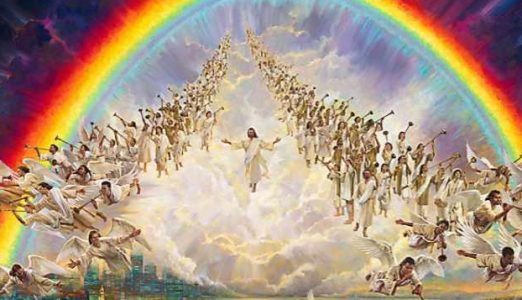
9 thoughts on “Debunking the Roman Catholic Church, Part II: Exposing Babylon. Desmontando a la Iglesia Católica Romana, Parte II: Desenmascarando a Babilonia.”